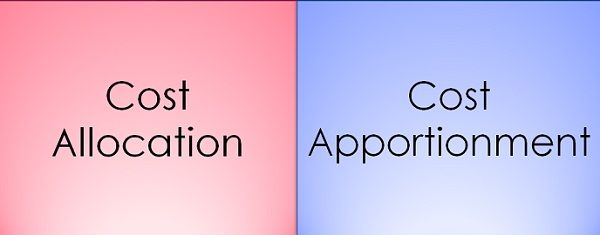 Departmentalization can be understood as a process of creating departments such as machining, personnel, fabrication, maintenance, stores, accounts, etc., in an organization, for the purpose of allocation and apportionment of overheads in a convenient way. The term allocation of cost is concerned with the complete cost items, whereas the apportionment of the cost is all about the proportion of cost items.
Departmentalization can be understood as a process of creating departments such as machining, personnel, fabrication, maintenance, stores, accounts, etc., in an organization, for the purpose of allocation and apportionment of overheads in a convenient way. The term allocation of cost is concerned with the complete cost items, whereas the apportionment of the cost is all about the proportion of cost items.
Based on the relation of the cost item with the cost center or unit, to which it is imposed, the cost item is allocated or apportioned and not as per the nature of the expense.
Take a read of this article excerpt, in which you can find the fundamental differences between allocation and apportionment of cost.
Content: Cost Allocation Vs Cost Apportionment
Comparison Chart
| Basis for Comparison | Cost Allocation | Cost Apportionment |
|---|---|---|
| Meaning | Allocation of cost, implies the entire distribution of the overhead item to the departments on a logical basis. | Apportionment of cost refers to distribution of various overhead items, in proportion, to the department on a logical basis. |
| Represents | It represents that part of cost attribution, which charges a particular cost to a cost unit. | It represents that part of cost attribution, which shares cost among multiple cost units, in the proportion of expected benefit received. |
| Distribution | Directly assigned to the department. | Proportionately assigned to different departments. |
| Application | When the overhead belongs to a specific department. | When the overhead belongs to different departments. |
Definition of Cost Allocation
Cost Allocation, as the name suggest, is the direct allotment of cost to the traceable cost object. It is the process of associating the expenses incurred, to different departments of the organization.
When a particular cost item is easily recognizable with a cost unit, i.e. product, or cost center, then these costs are charged to the concerned cost center or unit, and the process is called as cost allocation. In finer terms, it is the full-fledged distribution of an overhead item to the department, rationally.
Therefore, a process, in which there is an outright charging of whole cost items to the concerned cost center, is termed as cost allocation. The two factors responsible for cost allocation are:
- Respective cost unit or cost center, causing the overhead to be incurred.
- Definite amount of cost is to be calculated.
For instance: Salary paid to the employees of the maintenance department, can be allocated to that department.
Definition of Cost Apportionment
When the cost items cannot be outrightly charged to or accurately traceable to a particular cost center, then such items of cost are prorated amongst various cost objects, on an equitable basis, this process is known as cost apportionment. It is the distribution of different items of cost in proportions to the cost unit or cost center on a suitable basis.
In simple terms, the expenses which are unallowable are dispersed over multiple departments, is known as apportionment.
For instance: Wages paid to the head of the factory, rent of factory, electricity, etc. cannot be charged to a particular department, then these can be apportioned amongst various departments.
The basis for apportionment of costs is determined after proper examination of the relationship between the base and different variables. It is important to predetermine an appropriate basis for apportionment, which guarantees the equitable share of common overheads for the departments. The basis should be periodically reviewed, to improve the accuracy. It is based on the principles of:
- Service Rendered
- Survey or Analysis Method
- Ability to bear
- Efficiency
Key Differences Between Cost Allocation and Cost Apportionment
The difference between cost allocation and cost apportionment can be drawn clearly on the following grounds:
- Allocation of cost means a process in which the entire amount of overhead is charged to a specific cost center. On the contrary, Apportionment of cost can be understood as the distribution of proportions of cost items to the cost unit, i.e. product or service or the cost center.
- Allocation of the cost is possible only when the cost is recognized as particularly imputable to a specific cost center. Conversely, apportionment of the cost is needed when the cost cannot be allocated to a particular cost center. Instead, the cost is shared by two or more cost centers, as per the expected benefit received.
- As allocation of overhead is a sheer process of departmentalization of expenses, the overheads are directly assigned to the department. In contrast, cost apportionment involves the proportionate distribution of cost to different departments, on a reasonable basis.
- Cost allocation is applied when the overhead is associated with a particular department. As against this, cost apportionment is applied when the overhead is related to various departments.
Conclusion
Both allocation and apportionment of cost aim at identifying and assigning the cost to the cost center, but they are different. Cost Allocation is the process of assignment of cost item to the cost object, which is directly traceable. On the other hand, cost apportionment is for those indirect cost items, which are leftover in the process of cost allocation.






Azoo says
Satisfied
ricardo rodney says
wonderful. i would like to continue learning on this platform .